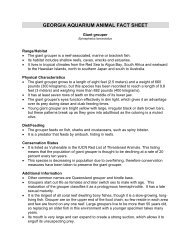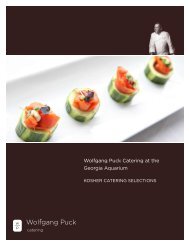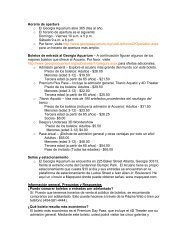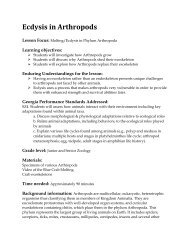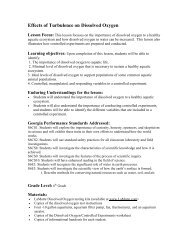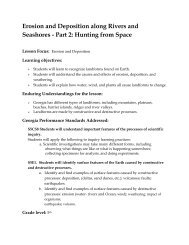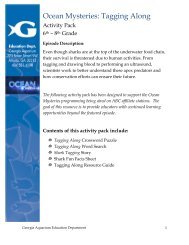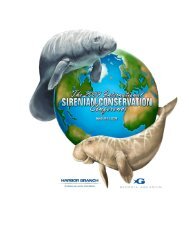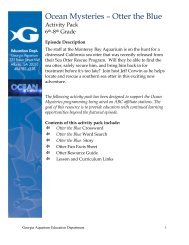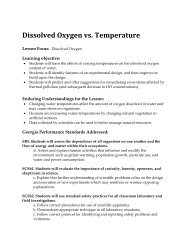3rd - 5th Grade Teacher Guide - Georgia Aquarium
3rd - 5th Grade Teacher Guide - Georgia Aquarium
3rd - 5th Grade Teacher Guide - Georgia Aquarium
Create successful ePaper yourself
Turn your PDF publications into a flip-book with our unique Google optimized e-Paper software.
Aqua Adventure <strong>Teacher</strong> <strong>Guide</strong><br />
<strong>Grade</strong>s 3-5<br />
Dear Educators,<br />
Thank you for visiting the <strong>Georgia</strong> <strong>Aquarium</strong> and extending your<br />
classroom to include our saltwater and freshwater habitats.<br />
The following guide has been designed to make your day at the <strong>Aquarium</strong><br />
engaging and fun for you and your students. We have divided it into four<br />
sections – lesson overview, student guide based on the galleries of the <strong>Aquarium</strong>,<br />
teacher guide and activities.<br />
Extension of your classroom: As educators ourselves, we are excited<br />
to offer you this as an extension of your own classroom. The following<br />
activities have been correlated to the third, fourth and fifth grade <strong>Georgia</strong><br />
Performance Standards. In just a morning or an afternoon you and your<br />
students can address the following objectives and GPS’s:<br />
Enduring Understandings:<br />
Scientists utilize a classification system to organize living things<br />
according to their characteristics.<br />
An animal’s conservation status is determined to create awareness,<br />
provide regulations, and protect that animal’s population.<br />
All organisms, whether they live in freshwater or marine ecosystems,<br />
have adaptations that allow them to survive in their natural habitats.<br />
Humans play an important role in maintaining healthy ecosystems and<br />
balancing natural processes.<br />
Organisms often exist in symbiotic relations which may include<br />
commensalism, mutualism and parasitism.<br />
Objectives:<br />
Students will classify organisms according to their physical<br />
characteristics.<br />
Students will explore the conservation status of various aquatic animals<br />
and learn what they can do to help protect them.<br />
Students will investigate the adaptations that allow an animal to survive<br />
successfully in its habitat.<br />
Students will identify the concept of symbiotic relationships and be<br />
aware of the interdependence of all organisms in an ecosystem.<br />
Students will know and discuss how humans play an important role in<br />
maintaining healthy marine and freshwater ecosystems.
<strong>Georgia</strong> Performance Standards Addressed:<br />
Third <strong>Grade</strong><br />
S3CS4: Students will use ideas of system, model, change and scale in exploring<br />
scientific and technological matters.<br />
a. Observe and describe how parts influence one another in things with many<br />
parts.<br />
b. Use geometric figures, number sequences, graphs, diagrams, sketches,<br />
number lines, maps and stories to represent corresponding features of objects,<br />
events and processes in the real world.<br />
S3L1: Students will investigate the habitats of different organisms and the dependence<br />
of organisms on their habitat.<br />
c. Identify features of animals that allow them to live and thrive in different<br />
regions of <strong>Georgia</strong>.<br />
d. Explain what will happen to an organism if the habitat is changed.<br />
S3L2: Students will recognize the effects of pollution and humans on the environment.<br />
a. Explain the effects of pollution (such as littering) to the habitats of plants and<br />
animals.<br />
b. Identify ways to protect the environment.<br />
Conservation of resources<br />
Recycling of materials<br />
ELA3R2: The student acquires and uses grade-level words to communicate effectively.<br />
The student<br />
a. Reads literary and informational text and incorporates new words into oral<br />
and written language.<br />
f. Determines the meaning of unknown words on the basis of context.<br />
ELA3R3: The student uses a variety of strategies to gain meaning from grade-level text.<br />
The student<br />
l. Identifies and infers cause-and-effect relationships and draws conclusions.<br />
ELA3LSV1: The student uses oral and visual strategies to communicate. The student<br />
b. Recalls, interprets and summarizes information presented orally.<br />
d. Listens to and views a variety of media to acquire information.<br />
Fourth <strong>Grade</strong><br />
S4CS4: Students will use ideas of system, model, change and scale in exploring<br />
scientific and technological matters.<br />
a. Observe and describe how parts influence one another in things with many<br />
parts.<br />
b. Use geometric figures, number sequences, graphs, diagrams, sketches,<br />
number lines, maps and stories to represent corresponding features of objects,<br />
events and processes in the real world. Identify ways in which the<br />
representations do not match their original counterparts.<br />
<strong>Georgia</strong> <strong>Aquarium</strong> – Education Department 2
S4L1: Students will describe the roles of organisms and the flow of energy within an<br />
ecosystem.<br />
a. Identify the roles of producers, consumers and decomposers in a community.<br />
b. Demonstrate the flow of energy through a food web/food chain beginning<br />
with sunlight and including producers, consumers and decomposers.<br />
c. Predict how changes in the environment would affect a community<br />
(ecosystem) of organisms.<br />
d. Predict effects on a population if some of the plants or animals in the<br />
community are scarce or if there are too many.<br />
S4L2: Students will identify factors that affect the survival or extinction of organisms<br />
such as adaptation, variation of behaviors (hibernation) and external features<br />
(camouflage and protection).<br />
a. Identify external features of organisms that allow them to survive or<br />
reproduce better than organisms that do not have these features (for example:<br />
camouflage, use of hibernation, protection, etc).<br />
ELA4R1: The student demonstrates comprehension and shows evidence of a warranted<br />
and responsible explanation of a variety of literary and informational texts. For<br />
informational texts, the student reads and comprehends in order to develop<br />
understanding and expertise and produces evidence of reading that:<br />
a. Locates facts that answer the reader’s questions.<br />
c. Identifies and uses knowledge of common graphic features (e.g., charts, maps,<br />
diagrams, illustrations).<br />
g. Makes perceptive and well-developed connections.<br />
ELA4R3: The student understands and acquires new vocabulary and uses it correctly in<br />
reading and writing. The student<br />
a. Reads a variety of texts and incorporates new words into oral and written<br />
language.<br />
b. Determines the meaning of unknown words using their context.<br />
Fifth <strong>Grade</strong><br />
S5CS4: Students will use ideas of system, model, change and scale in exploring<br />
scientific and technological matters.<br />
a. Observe and describe how parts influence one another in things with many<br />
parts.<br />
b. Use geometric figures, number sequences, graphs, diagrams, sketches,<br />
number lines, maps and stories to represent corresponding features of objects,<br />
events and processes in the real world. Identify ways in which the<br />
representations do not match their original counterparts.<br />
S5L1: Students will classify organisms into groups and relate how they determined the<br />
groups with how and why scientists use classification.<br />
a. Demonstrate how animals are sorted into groups (vertebrate and<br />
invertebrate) and how vertebrates are sorted into groups (fish, amphibian,<br />
reptile, bird and mammal).<br />
<strong>Georgia</strong> <strong>Aquarium</strong> – Education Department 3
ELA5R1: The student demonstrates comprehension and shows evidence of a warranted<br />
and responsible explanation of a variety of literary and informational texts. For<br />
informational texts, the student reads and comprehends in order to develop<br />
understanding and expertise and produces evidence of reading that:<br />
a. Locates facts that answer the reader’s questions.<br />
c. Identifies and uses knowledge of common graphic features (e.g., charts, maps,<br />
diagrams, captions and illustrations).<br />
d. Identifies and uses knowledge of common organizational structures (e.g.,<br />
chronological order, logical order, cause and effect, classification schemes).<br />
g. Makes perceptive and well-developed connections.<br />
ELA5R3: The student understands and acquires new vocabulary and uses it correctly in<br />
reading and writing. The student<br />
a. Reads a variety of texts and incorporates new words into oral and written<br />
language.<br />
b. Determines the meaning of unfamiliar words using context clues (e.g.,<br />
definition, example).<br />
Overall Format: Each gallery has a few stops at which we recommend you spend a<br />
little more time at with your students. Each stop is highlighted by an exhibit overview<br />
and some guiding questions for the students (and answers for the adults). These<br />
questions are meant to help highlight key concepts for your group, whether it be<br />
observing an animal’s behavior or simply finding some of our favorite animals in the<br />
exhibit. Students will need to bring clipboards (or another type of board) and writing<br />
utensils with them to complete the activities.<br />
To help you use the space, there are small markers next to each stop to guide you on<br />
how we use these spaces every day with groups of all ages.<br />
Whenever your group is in front of the larger gallery windows at the <strong>Aquarium</strong>, we<br />
ask that students sit cross-legged in a few rows close to the window. If all students sit<br />
on their bottoms and not on their knees, everyone in the group is able to see. We<br />
recommend rows of about 7 so that no group takes up more than about one-third of a<br />
window at a time and everyone behind the group can see.<br />
At our touch pools, students will have the opportunity to explore using their<br />
senses. For the safety of the animals, please make sure the students are touching softly<br />
with two fingers and not grabbing. Some students might not be tall enough to reach all<br />
of the animals. Please make sure that you watch your students carefully for their safety<br />
as well as that of the animals. (Please note: many of our touch pools may have shellfish<br />
residue in the water.)<br />
Some things at the <strong>Aquarium</strong> are only seen when you are looking for them. These<br />
animals are always fun to try and find in the exhibit while playing a quick game of “Ispy”.<br />
<strong>Georgia</strong> <strong>Aquarium</strong> – Education Department 4
Your groups: While at the <strong>Aquarium</strong>, the smaller the individual groups the better. We<br />
recommend one chaperone with five to seven students. This allows everyone to see the<br />
exhibits and helps with traffic in the galleries. We also recommend that your entire<br />
group not start at the same gallery. There are 5 galleries; have the students split up,<br />
start in different galleries and rotate.<br />
Here is our recommendation on how to rotate:<br />
<strong>Georgia</strong> Explorer<br />
Tropical Diver<br />
Atrium<br />
River Scout<br />
Ocean Voyager<br />
Cold Water Quest<br />
Considering that every gallery exits to the main atrium, it is easy to set up an end<br />
meeting point for all groups before exiting through the gift shop or eating. We<br />
recommend all the adults pick up a map when you enter the <strong>Aquarium</strong> to help orient<br />
you in the building.<br />
Rules: Finally, to ensure a great visit, we ask that you share the following rules with<br />
your students and chaperones for the safety of our animals and your students.<br />
No running<br />
Be respectful of the other guests<br />
No horseplay, pushing or shoving<br />
Use indoor voices<br />
No tapping on the windows – it can be very bothersome to our animals<br />
Stay with your chaperones/students at all times<br />
No gum<br />
Only touch with two fingers<br />
We hope you have an amazing day here at the <strong>Georgia</strong> <strong>Aquarium</strong>, the world’s most<br />
engaging aquarium, and that the tips and tricks listed in this guide are useful in<br />
extending your classroom to our watery world. Please be sure to complete our online<br />
<strong>Teacher</strong> Survey!<br />
Best Fishes!<br />
The <strong>Georgia</strong> <strong>Aquarium</strong> Education Department<br />
<strong>Georgia</strong> <strong>Aquarium</strong> – Education Department 5
Aqua Adventure<br />
Student <strong>Guide</strong><br />
<strong>Grade</strong>s 3 rd – 5 th<br />
Welcome to the <strong>Georgia</strong> Explorer gallery! Here we will use our senses to discover the animals<br />
that share our home state with us. Get those two scientific fingers ready to explore and learn!<br />
VISIT the shark and ray touch pool! (Please note: many of our touch pools may<br />
have shellfish residue in the water.) To reach down, make sure you lie on your belly on<br />
the rocks and touch the animals lightly on their backs. (Use two fingers and touch<br />
gently; don’t hold your paper over the water!) Name the two species found in this<br />
touch pool:<br />
_________________ rays<br />
_________________ sharks<br />
DRAW one of the stingrays you touched and identify the eyes, mouth, gills, spiracles<br />
(openings behind the eyes) and pectoral fins (side fins).<br />
<strong>Georgia</strong> <strong>Aquarium</strong> – Education Department 6
VISIT the lionfish exhibit. What makes them an invasive species?<br />
____________________________________________________________________________<br />
Where did they first appear in the Atlantic Ocean? _______________________________<br />
What is their range now?______________________________________________________<br />
The Gray’s Reef touch pool exhibit is located in front of the Gray’s Reef window.<br />
TOUCH a sea urchin using a two-finger touch. ASK a <strong>Georgia</strong> <strong>Aquarium</strong> staff<br />
member for information on the animal you just touched.<br />
Where is the sea urchin’s mouth? ______________________________________________<br />
What animals are they closely related to? _______________________________________<br />
FIND the loggerhead sea turtle! Sometimes it likes to swim and sometimes it likes<br />
to nap under the rocks.<br />
How does a sea turtle protect itself? _____________________________________________<br />
Name one thing about a sea turtle’s body that is different from a land turtle’s body:<br />
______________________________________________________________________________<br />
Use the computer kiosk to identify two fish in the exhibit by clicking the “more fish”<br />
button.<br />
_____________________________<br />
___________________________________<br />
TAKE the stairs up to the second level. SLIDE down the whale slide to the first floor!<br />
<strong>Georgia</strong> <strong>Aquarium</strong> – Education Department 7
Rivers and lakes are a huge part of our lives! Wherever you go you will find freshwater habitats all<br />
over the world. They are important to us and all the many different animals that live there! Let’s go<br />
discover just how different all these animals can be. As you go through the gallery, fill in the blanks<br />
on the world map with the names of some animals that might live there:<br />
CRAWL through the tunnel under the river! The river above your head is a North<br />
American river that has many different kinds of fish. Look at all the different kinds of mouths<br />
these animals have! While in the tunnel, peek through the windows and find a fish with a<br />
long, skinny nose. That is a gar.<br />
CHECK OUT the banded archer fish. This amazing fish is able to use its jaw<br />
muscles and the roof of its mouth to create a channel to pump water out of to strike its<br />
prey. It can fire streams of water up to about ____________.<br />
Next, stop by the American alligator exhibit and LOOK at these reptiles. In the<br />
wild, alligators are ambush predators, meaning they wait for their food to swim by and<br />
then reach out and grab it.<br />
Where do you think alligators are on the food chain? Top or bottom?<br />
Take a good look at the alligators. How are they different from the ones in the video?<br />
__________________________________________________________________________<br />
Do you know why the alligators don’t eat the fish in the exhibit? It’s because we feed<br />
them so well they don’t need to snack, just like with the sharks!<br />
<strong>Georgia</strong> <strong>Aquarium</strong> – Education Department 8
LOOK and COMPARE the longnose gar located in the river above the American<br />
alligator exhibit to the alligator. Observe the animals for a few minutes and complete<br />
the chart below. Once finished, determine the classification of each animal (mammal,<br />
fish, reptile, bird, amphibian, etc.) based on the characteristics listed below.<br />
Longnose gar Characteristic Alligator<br />
Covering:<br />
Fur, scales, blubber, skin,<br />
feathers<br />
Breathing:<br />
Gills or lungs<br />
Movement:<br />
Fins, tail, legs, feet<br />
Coloring/Pattern:<br />
Draw the patterns you<br />
see<br />
Habitat:<br />
Water, land, land &<br />
water<br />
Vertebrate or<br />
Invertebrate<br />
Cold or Warm blooded<br />
What type of animal?<br />
Mammal, bird, reptile,<br />
fish, amphibian<br />
WATCH the piranha. How large can they grow?______________________________<br />
OBSERVE the Asian small-clawed otters for a few minutes. What are they doing?<br />
______________________________________________________________________________<br />
What makes Asian small-clawed otters different from all other otter species?<br />
a. They are the biggest species of otter.<br />
b. They use their paws to hunt.<br />
c. They don’t have tails.<br />
Name two human activities that impact the natural habitat of the Asian small-clawed<br />
otter: ______________________________________________________________________<br />
<strong>Georgia</strong> <strong>Aquarium</strong> – Education Department 9
From Oregon to Japan, from southern Australia to South Africa, cold ocean waters teem<br />
with fish and marine mammals. Beneath the waves curious animals hang out among<br />
rocky ledges and kelp forests.<br />
Our first stop is the Kelp Forest Exhibit at the entrance of the gallery. This exhibit and<br />
the touch pool across the way show the fragile animals found in tide pools and kelp<br />
forests on the coast from California to Washington. (Please note: many of our touch<br />
pools may have shellfish residue in the water.)<br />
<br />
<br />
The garibaldi fish inspired our <strong>Aquarium</strong> mascot, named ___________.<br />
Can you find the senorita fish or the swell shark? Where do they each live in a<br />
kelp forest? __________________________________________________________<br />
Come SIT by the beluga whales and relax. Listen to the <strong>Aquarium</strong> staff on the<br />
microphone as they will be sharing some great information about these amazing animals.<br />
Where do beluga whales live in the wild? ________________________<br />
Which belugas are in the exhibit? ___________________________________<br />
How do the following adaptations help belugas survive?<br />
Adaptation<br />
Dorsal ridge<br />
Function<br />
Flexible neck and lips<br />
Thick blubber<br />
Melon (vocalization)<br />
Blowhole<br />
Your next stop is our giant Pacific octopus! Can you find it in the exhibit?<br />
An octopus can change the color and texture of their skin in an instant. How does this<br />
adaptation help them survive? ________________________________________________<br />
___________________________________________________________________________<br />
How small of a space can an octopus fit through?________________________________<br />
On your way to the southern sea otters, check out how the weedy sea dragons use their<br />
leafy appendages to help them hide. What is it called when an animal blends in with<br />
its surroundings?<br />
____________________________________________________________________________<br />
<strong>Georgia</strong> <strong>Aquarium</strong> – Education Department 10
VIEW the southern sea otters. Southern sea otters are different from other otters in<br />
that they spend most of their time in the water. How do they stay warm since they<br />
don’t have blubber?<br />
______________________________________________________________________________<br />
How do they keep from drifting away in the water?<br />
______________________________________________________________________________<br />
DID YOU KNOW: Southern sea otters eat many types of prey including sea urchins,<br />
snails, mussels, crabs, scallops, fish, barnacles, octopus, worms and squid. They must<br />
eat 25 percent of their body weight every day to maintain their normal body<br />
temperature in this cold environment. Our adult otters, Oz and Gracie, consume<br />
approximately 12 pounds of food daily to stay warm.<br />
CRAWL through the penguin tunnel. What type of animal are penguins? _______<br />
These animals live on the southern tip of Africa where the water is very cold. What<br />
adaptation do they have to stay warm?___________________________________________<br />
SIT behind the railing that overlooks the beluga window. List one way that a<br />
beluga and harbor seal are different from each other.<br />
Belugas: ____________________________________________________________________<br />
Harbor seals:________________________________________________________________<br />
<strong>Georgia</strong> <strong>Aquarium</strong> – Education Department 11
Welcome to the world ocean! We call it the world ocean because all our oceans are part<br />
of one large ocean that covers the entire world allowing these animals to roam from one<br />
ocean to another. The adults in the groups should pick up an identification card at the<br />
beginning of the gallery to help identify the animals.<br />
At the viewing theater of Ocean Voyager exhibit OBSERVE a whale shark.<br />
Label the drawing below with the following parts: eyes, gill slits, dorsal fin, caudal (or<br />
tail) fin, pectoral fin and mouth:<br />
.<br />
Now, OBSERVE a giant grouper, whale shark and manta ray. Note the<br />
following characteristics to discover similarities and differences between these animals.<br />
Feature Whale shark Giant grouper Manta ray<br />
Location of mouth<br />
Location of gills<br />
Number of gill<br />
slits/openings on<br />
each side<br />
How does it<br />
move?<br />
Color/patterns?<br />
<strong>Georgia</strong> <strong>Aquarium</strong> – Education Department 12
The giant grouper is considered an ambush predator, which means they sit and wait for<br />
their prey to swim by and grab it. What adaptation would help them hunt for their<br />
food?<br />
a. Eyes that move without their head turning.<br />
b. A large tail for quick bursts of speed.<br />
c. A large mouth to swallow smaller fish whole.<br />
d. All of the above.<br />
A whale shark does not chew its food and, while its mouth can<br />
be up to four feet wide, its throat is only approximately this big<br />
What size food do you think a whale shark eats? ________________________<br />
FOOD CHAIN: Based on what you have learned and seen so far in the aquarium,<br />
draw or write a food chain one might find in the ocean with arrows to show what eats<br />
what. Be sure to LABEL the producers (an organism that produces its own food from<br />
sunlight) and consumers (an organism that feeds on the tissues of producers or other<br />
consumers).<br />
For example:<br />
whale shark<br />
(consumer)<br />
zooplankton<br />
(like krill)<br />
(consumer)<br />
phytoplankton<br />
(algae)<br />
(producer)<br />
sunlight<br />
Your turn!<br />
If you took one of the animals out of the food chain, how would that affect the whole<br />
ecosystem?<br />
______________________________________________________________________________<br />
______________________________________________________________________________<br />
<strong>Georgia</strong> <strong>Aquarium</strong> – Education Department 13
Welcome to the peaceful waters of the warm tropical ocean that surrounds the equator.<br />
Here we will find the wildest colors you will see all day! These animals are very good at<br />
being seen when they want to be and hiding when they don’t. Let’s see what we can<br />
find!<br />
At the first Tropical Diver exhibit, WATCH the garden eels. How do they<br />
protect themselves from predators? ______________________________________________<br />
Why do you think the garden eels all face the same direction? ______________________<br />
_____________________________________________________________________________<br />
After observing the sea horse exhibit, head to the jellies exhibits. These interesting<br />
looking animals do not have body parts common to other animals. They don’t have<br />
eyes, a mouth, gills, a nose, etc. Jellies use their tentacles and oral arms to eat. They have<br />
stinging cells called nematocysts on their tentacles, which paralyze their prey. The<br />
tentacles bring the food to the oral arms, which start the digestion process as it moves<br />
the food to their stomach in the bell.<br />
LABEL the body parts of the Pacific sea nettle: the bell, tentacles, and oral arms.<br />
VISIT the main window in our Tropical Diver exhibit. Enjoy the beautiful, colorful<br />
fish that swim around. Don’t miss the wave as it crashes above your head!<br />
One of the smallest animals that lives on the coral reef is the coral polyp. There can be<br />
thousands of polyps living on each piece of coral. Corals get most of their food from<br />
algae, called zooxanthellae, which live inside them. Zooxanthellae use energy from the<br />
sun to create food for the coral using photosynthesis (just like plants).<br />
Coral polyps also have tentacles with nematocysts to catch food. What animal do you<br />
think they are related to? (HINT: you just visited it) _____________________________<br />
<strong>Georgia</strong> <strong>Aquarium</strong> – Education Department 14
DRAW one of the interesting animals in our coral reef.<br />
Use the kiosks at the back of the exhibit. LOOK UP three coral reef animals,<br />
including the one you just drew, and record their information below. See if you can<br />
find the other two in the exhibit (be sure to look everywhere).<br />
Animal’s<br />
name<br />
How big will<br />
it get?<br />
Color<br />
Interesting fact<br />
Did you find it in<br />
the exhibit?<br />
Where?<br />
So far in this gallery you have seen different types of vertebrates (like garden eels)<br />
and invertebrates (like jellies).<br />
What is the difference between a vertebrate and an invertebrate?<br />
_______________________________________________________________<br />
The wave machine helps the exhibit by providing a lot of water movement for the coral<br />
reef animals. How else do you think it helps the reef?<br />
a. It distributes food throughout the exhibit.<br />
b. It mixes oxygen into the water.<br />
c. It looks cool.<br />
d. All of the above.<br />
<strong>Georgia</strong> <strong>Aquarium</strong> – Education Department 15
<strong>Teacher</strong> <strong>Guide</strong><br />
GEORGIA EXPLORER<br />
*** There are several touch pools in <strong>Georgia</strong> Explorer. Please have the students touch<br />
the animals gently, with two fingers. Also be careful to keep papers and pencils out<br />
of the water. A hand sanitizer station is to the left of the entrance/exit of the gallery.<br />
(Please note: many of our touch pools may have shellfish residue in the water.)<br />
VISIT the shark and ray touch pool! To reach down, make sure you lie on your belly<br />
on the rocks and touch the animals lightly on their backs. (Use two fingers and touch<br />
gently; don’t hold your paper over the water!) Name the two species found in this<br />
touch pool:<br />
cownose rays<br />
bonnethead sharks<br />
DRAW one of the stingrays you touched and identify key features such as eyes, mouth,<br />
gills, spiracles, dorsal fin, pectoral fin and caudal (tail) fin.<br />
VISIT the lionfish exhibit. What makes them an invasive species?<br />
They are not native to the Atlantic Ocean, but were introduced from the Indo-Pacific<br />
region. They are harmful because they are voracious eaters and don’t have any<br />
natural predators.<br />
The Gray’s Reef touch pool exhibit is located in front of the Gray’s Reef window. Have<br />
the students use a two-finger touch to touch a sea urchin. Have them ask a <strong>Georgia</strong><br />
<strong>Aquarium</strong> staff member for more information. (Please note: many of our touch pools<br />
may have shellfish residue in the water.)<br />
Where is the sea urchin’s mouth? Underneath, in the middle of their body.<br />
What animals are they closely related to? Sea stars, sand dollars and sea biscuits.<br />
FIND the loggerhead sea turtle! Sometimes it likes to swim and sometimes it likes to<br />
nap under the rocks.<br />
How does a sea turtle protect itself? Their hard shell (called a carapace).<br />
Name one thing about sea turtle’s body that is different from a land turtle’s body:<br />
Flippers instead of webbed feet, cannot pull head inside of shell, shell is more<br />
streamlined.<br />
Use the computer kiosk to identify two fish in the exhibit by clicking the “more fish”<br />
button. Answers will vary.<br />
<strong>Georgia</strong> <strong>Aquarium</strong> – Education Department 16
TAKE the stairs up to the second level. SLIDE down the whale slide to the first floor!<br />
*** Students should slide down one at a time, feet first only. They must wait until the<br />
last person is out of the slide before going down. One teacher/chaperone should wait at<br />
the bottom of the slide while another goes to the entrance of the slide with the students.<br />
RIVER SCOUT<br />
Rivers and lakes are a huge part of our lives! Wherever you go you will find freshwater<br />
habitats all over the world. They are important to us and all the many different animals that<br />
live there! Let’s go discover just how different all these animals can be. As you go through the<br />
gallery, fill in the blanks on the world map with the names of some animals that might live<br />
there:<br />
Mississippi River: gar, catfish, bass, carp, big mouth buffalo, blue gill<br />
Amazon River: discus, tetra, electric eel, piranha<br />
Lake Tanganyika/Malawi: all cichlids<br />
S.E. Asia: Asian small-clawed otters<br />
CRAWL through the tunnel under the river! The river above your head is a North American<br />
river that has many different kinds of fish. Look at all the different kinds of mouths these<br />
animals have! While in the tunnel, peek through the windows and find a fish with a long,<br />
skinny nose. That is a gar.<br />
CHECK OUT the banded archer fish. This amazing fish is able to use its jaw muscles and the<br />
roof of its mouth to create a channel to pump water out of to strike its prey. It can fire streams<br />
of water up to about 5 feet.<br />
Next, stop by the American alligator exhibit and LOOK at these reptiles. In the wild<br />
alligators are ambush predators, meaning they wait for their food to swim by and then<br />
reach out and grab it.<br />
Where do you think alligators are on the food chain? Top or bottom?<br />
Take a good look at the alligators. How are they different from the ones in the video?<br />
They are albino: their bodies lack pigment.<br />
Do you know why the alligators don’t eat the fish in the exhibit? It’s because we feed<br />
them so well they don’t need to snack, just like with the sharks!<br />
LOOK and COMPARE the longnose gar located in the river above the<br />
American alligator exhibit to the alligator. Observe the animals for a few minutes and<br />
complete the chart below. Once finished, determine the classification of each animal<br />
(mammal, fish, reptile, bird, amphibian, etc.) based on the characteristics listed below.<br />
List them in the blanks.<br />
<strong>Georgia</strong> <strong>Aquarium</strong> – Education Department 17
Longnose gar Characteristic Alligator<br />
scales Covering scales<br />
gills Breathing air<br />
tail Movement tail<br />
Coloring/Pattern<br />
water<br />
Habitat<br />
Land and water<br />
(water, land, land & water)<br />
vertebrate Vertebrate or Invertebrate vertebrate<br />
cold Cold or Warm blooded cold<br />
fish What type of animal? reptile<br />
WATCH the piranha. How large can they grow? 13 inches.<br />
OBSERVE the Asian small-clawed otters for a few minutes. What are they doing?<br />
Answers will vary: sleeping, playing, eating, etc.<br />
What makes Asian small-clawed otters different from all other otter species?<br />
a. They are the biggest species of otter.<br />
b. They use their paws to hunt.<br />
c. They don’t have tails.<br />
Name two human activities that impact the natural habitat of the Asian small-clawed<br />
otter: Hunting and development of land.<br />
COLD WATER QUEST GALLERY<br />
Our first stop is in the Kelp Forest Exhibit at the entrance of the gallery. *** Gather<br />
students in a tight group in front of the kelp forest to avoid traffic jams at the gallery<br />
entrance.<br />
This exhibit and the touch pool across the way show the fragile animals found in tide<br />
pools and kelp forests in the northwestern United States from California to Washington.<br />
<br />
The garibaldi fish inspired our <strong>Aquarium</strong> mascot, named Deepo.<br />
<strong>Georgia</strong> <strong>Aquarium</strong> – Education Department 18
Can you find the senorita fish or the swell shark? Where do they each live in a kelp<br />
forest? Senorita fish will be swimming in the kelp plants and the swell shark<br />
usually remains on the bottom.<br />
Come SIT by the beluga whales and relax. Listen to the <strong>Aquarium</strong> staff on the<br />
microphone as they will be sharing some great information about these amazing<br />
animals. *** Seat children in one tight group (in rows of about 7 students each) in front<br />
of the window to allow space for other school groups and visitors.<br />
Where do beluga whales live in the wild? They are found primarily in the arctic region<br />
which includes the north Atlantic and Pacific Oceans, Bering Sea, Hudson Bay and<br />
St. Lawrence River.<br />
Which belugas are in the exhibit? Beethoven , Maris, Grayson and/or Qinu.<br />
How do the following adaptations help belugas survive?<br />
Adaptation<br />
Dorsal ridge<br />
Flexible neck and lips<br />
Thick blubber<br />
Melon (vocalization)<br />
Blowhole<br />
Function<br />
Conserves body heat (less surface area than dorsal fin);<br />
can be used to break ice for breathing<br />
Helps belugas reach and pick up food from ocean floor<br />
(they swim too slowly to chase schools of fish)<br />
Layers of fat that keep belugas warm in icy waters<br />
Use sounds to communicate, also to navigate and hunt by<br />
echolocation<br />
Breathe without exposing the whole head to predators above<br />
water<br />
Your next stop is our giant Pacific octopus! An octopus can change the color<br />
and texture of their skin in an instant. How does this adaptation help them survive?<br />
It helps them communicate with other octopi and hide.<br />
How small of a space can an octopus fit through? The size of a quarter.<br />
On your way to the southern sea otters, check out how the weedy sea dragons use their<br />
leafy appendages to help them hide. What is it called when an animal blends in with<br />
its surroundings? Camouflage.<br />
VIEW the southern sea otters. Southern sea otters are different from other otters in that<br />
they spend most of their time in the water. How do they stay warm since they don’t<br />
have blubber? They have the densest fur of any animal (approximately 1 million<br />
hairs per square inch); hold less furry paws out of the water; eat all day long to keep<br />
their metabolism high.<br />
How do they keep from drifting away in the water? They wrap kelp around their<br />
bodies while they sleep.<br />
<strong>Georgia</strong> <strong>Aquarium</strong> – Education Department 19
DID YOU KNOW: Southern sea otters eat many types of prey including sea urchins,<br />
snails, mussels, crabs, scallops, fish, barnacles, octopus, worms and squid. They must<br />
eat 25 percent of their body weight every day to maintain their normal body<br />
temperature in this cold environment. Our adult otters, Oz and Gracie, consume<br />
approximately 12 pounds of food daily to stay warm.<br />
CRAWL through the penguin tunnel. What type of animal are penguins? Birds.<br />
These animals live on the southern tip of Africa where the water is very cold. What<br />
adaptation do they have to stay warm? Some blubber and waterproof feathers.<br />
SIT behind the railing that overlooks the beluga window. ***Have students sit in 2-3<br />
rows, close together.*** The harbor seals have fur, like the otters, as well as blubber like<br />
the belugas.<br />
List one way that belugas and harbor seals are different from each other.<br />
Belugas: Belugas have a blowhole that they use when breathing; seals do not.<br />
Harbor seals: The seals have paws and skin flaps to store food items; belugas have<br />
pectoral fins used only for swimming.<br />
OCEAN VOYAGER<br />
<strong>Teacher</strong>s: Pick up a species ID card before you enter the Ocean Voyager gallery.<br />
*** The Ocean Voyager tunnel is best used for simply viewing the animals. Activities<br />
should be done at the main window. At the window, please have the students sit in a<br />
tight group rather than one long row to leave space for others.<br />
LABEL the whale shark drawing below with the following parts: eyes, gill slits, dorsal<br />
fin, caudal fin, pectoral fin and mouth:<br />
Gill slits<br />
Dorsal fin<br />
Caudal fin<br />
Mouth<br />
Eye<br />
.<br />
Pectoral fin<br />
Now, OBSERVE a giant grouper, whale shark and manta ray. Note the<br />
following characteristics to discover similarities and differences between these animals.<br />
<strong>Georgia</strong> <strong>Aquarium</strong> – Education Department 20
Feature Whale shark Giant grouper Manta ray<br />
Location of mouth Front Front Front<br />
Location of gills Side Side Bottom<br />
Number of gill<br />
slits/openings on<br />
5 1 5<br />
each side<br />
How does it move?<br />
Color/patterns?<br />
Tail moves side to<br />
side<br />
Black with white<br />
spots on top and<br />
white belly<br />
Tail moves side to<br />
side<br />
Light grey with<br />
black spots<br />
Wings move up<br />
and down<br />
Black and/or white<br />
on top and white<br />
and black on<br />
bottom<br />
The giant grouper is considered an ambush predator (they hide in dark spaces and watch<br />
for food). What adaptation would help them hunt for their food?<br />
*d. All of the above.<br />
A whale shark does not chew its food and, while its mouth can be up to four feet wide,<br />
its throat is only approximately the size of a quarter or half dollar. What size food do<br />
you think a whale shark eats? Small food like plankton.<br />
FOOD CHAIN: Based on what you have learned and seen so far in this aquarium,<br />
draw a food chain one might find in the ocean with arrows to show what eats what. Be<br />
sure to label the producers and consumers.<br />
For example:<br />
whale shark<br />
(consumer)<br />
zooplankton<br />
(e.g. krill)<br />
(consumer)<br />
phytoplankton<br />
(algae)<br />
(producer)<br />
sunlight<br />
Answers will vary.<br />
If you took one of the animals out of the food chain, how would that affect the<br />
ecosystem? Basic: some animals would increase because of no predation; others<br />
would decrease because of no prey. Example: if sea otters were removed, sea urchin<br />
populations would increase, sea urchins would consume kelp forests, other animals’<br />
habitat would be destroyed (animals that hide in kelp forest).<br />
***Drop off the Species ID card in the container as you exit the Ocean Voyager gallery.<br />
<strong>Georgia</strong> <strong>Aquarium</strong> – Education Department 21
TROPICAL DIVER<br />
At the first Tropical Diver exhibit, WATCH the garden eels. How do they protect<br />
themselves from predators? They hide in their burrows.<br />
Why do you think the garden eels all face the same direction? They face the current to<br />
catch food.<br />
After observing the sea horse exhibit, head to the jellies exhibit. These interesting<br />
looking animals do not have body parts common to other animals. They don’t have<br />
eyes, a mouth, gills, a nose, etc. Jellies use their tentacles and oral arms to eat. They have<br />
stinging cells called nematocysts on their tentacles, which paralyze their prey. The<br />
tentacles bring the food to the oral arms, which start the digestion process as it moves<br />
the food to their stomach in the bell.<br />
LABEL the body parts of the Pacific sea nettle:<br />
the bell, tentacles (long, spaghetti-like structures)<br />
and oral arms (lacy structures).<br />
VISIT the main window in our Tropical Diver exhibit. *** Seat children in one tight<br />
group (3-4 rows) at the window to leave space for others. Enjoy the beautiful, colorful<br />
fish that swim around. Don’t miss the wave as it crashes above your head!<br />
One of the interesting animals that lives on the coral reef is the coral polyp. There can be<br />
thousands of polyps living on each piece of coral. Corals get most of their food from<br />
algae, called zooxanthellae, which live inside them. Zooxanthellae use energy from the<br />
sun to create food for the coral using photosynthesis (just like plants).<br />
Coral polyps also have tentacles with nematocysts to catch food. What animal do you<br />
think they are related to? Jellies and sea anemones – also have stinging tentacles.<br />
DRAW one of the interesting animals in our coral reef. Answers will vary.<br />
Use the kiosks at the back of the exhibit. LOOK UP three animals, including the one<br />
you just drew, and record their information below. See if you can find the other two in<br />
the exhibit (be sure to look everywhere). Answers will vary based on the animals<br />
selected.<br />
Animal’s<br />
name<br />
How big will it<br />
get?<br />
Color Interesting fact Did you find it in the<br />
exhibit? Where?<br />
<strong>Georgia</strong> <strong>Aquarium</strong> – Education Department 22
So far in this gallery you have seen different types of vertebrates (like garden eels)<br />
and invertebrates (like jellies). What is the difference between a vertebrate and<br />
invertebrate? Vertebrates have back bones and invertebrates don’t.<br />
The wave machine helps the exhibit by providing a lot of water movement for the coral<br />
reef animals. How else do you think it helps the reef?<br />
a. It distributes food throughout the exhibit.<br />
b. It mixes oxygen into the water.<br />
c. It looks cool.<br />
d. All of the above<br />
<strong>Georgia</strong> <strong>Aquarium</strong> – Education Department 23
Water Address<br />
Adapted from the Project WET K-12 Curriculum & Activity <strong>Guide</strong>.<br />
<strong>Grade</strong>: 3 rd – 5 th<br />
Objective: Students will identify aquatic animals and their habitats by analyzing<br />
clues that describe the animals’ adaptations.<br />
Duration: 50 minutes<br />
Vocabulary: adaptation, camouflage, coral reef, fish, mammal, freshwater, saltwater,<br />
predator, prey<br />
Background:<br />
Three-quarters of Earth’s surface is covered with water. There are many different types<br />
of aquatic habitats such as the open ocean, coral reefs, lakes, rivers, marshes and<br />
swamps. To survive in these different environments animals have special features or<br />
adaptations. These adaptations have developed over time and serve several important<br />
purposes. They can help an organism get food, protect themselves from enemies, and<br />
survive in many different conditions.<br />
There are many ways in which animals have adapted to survive in aquatic habitats.<br />
Fish have streamlined bodies and fins to help them move through the water quickly.<br />
Their coloration helps them to hide from predators or helps predators sneak up on their<br />
prey. Some fish have added protections such as spines and spots on the back half of<br />
their bodies to confuse their predators. Fish also have gills so that they are able to filter<br />
the oxygen out of the water to breathe. Some aquatic birds have webbed feet for<br />
swimming as well as glands that produce waxy oil for waterproofing their feathers.<br />
Aquatic animals also have adaptations to allow them to survive in severe temperatures.<br />
For example, animals like belugas and sea lions have blubber (a thick layer of fat<br />
beneath their skin) to protect them from cold water. Sea otters do not have blubber, but<br />
they have very thick fur that serves the same function.<br />
Materials:<br />
10 sets of “Adaptation Cards” for each group of students<br />
Pencils and paper for scorekeeping<br />
10 sets of animal picture cards (optional)<br />
10 sets of habitat cards (optional)<br />
Globe or world map (optional)<br />
Procedure:<br />
1. Discuss how Earth’s surface is covered with approximately 71% of water and<br />
demonstrate this using a globe or map. Aquatic habitats are home to thousands of<br />
species of animals. Tell the students that today they are going to learn about<br />
<strong>Georgia</strong> <strong>Aquarium</strong> – Education Department 24
different aquatic habitats, some of the animals that live there, and the adaptations<br />
that allow them to survive in their habitat.<br />
2. Make a list on the board with the students of all the aquatic habitats they can think<br />
of. Make sure to include both freshwater and saltwater habitats. (Discuss the<br />
difference between these two terms if necessary.)<br />
3. Tell the students that each one of these habitats includes animals that have adapted<br />
to the specific conditions of that habitat to be able to survive there. Have the<br />
students define adaptation. Give an example such as fish adapting to live in water<br />
by having gills.<br />
4. Tell the students they are going to play a riddle game in which they must guess an<br />
organism’s identity and “water address” (or habitat) based on the clues on the<br />
adaptation card. Have students form groups of three or four.<br />
5. Hand out a set of the “Adaptation Cards”, “Animal Cards”, and “Habitat Cards” to<br />
each group (last two sets are optional depending on your group). Instruct students<br />
to spread out the animal and habitat cards on their desks or floor.<br />
6. Explain that each card lists four adaptations of a certain animal. Based on the clues,<br />
students will match the animal and the habitat to the adaptations on the card<br />
(animal and habitat cards are an extra help for students).<br />
7. Each student in the group should take turns being the “reader”. The reader starts<br />
the game by picking an “Adaptation Card” and reading the clues one at a time until<br />
another student in the group correctly identifies the animal and the habitat (using<br />
the pictures for help). Answers are listed at the bottom of each card.<br />
8. The student who correctly guesses both the name of the organism and its water<br />
address (habitat) receives points for the group (a scorekeeper should keep track of<br />
the group’s points). Keep track of the score as follows:<br />
a. One clue read = four points<br />
b. Two clues read = three points<br />
c. Three clues read = two points<br />
d. Four clues read = one point<br />
9. Have the students continue playing the game and keeping track of the group’s score<br />
until all the adaptation cards have been used. The group then tallies up their score<br />
and when all groups have finished they can compare their score with other groups<br />
to determine a winner!<br />
10. To wrap up, make a list with the students of all the different water-related<br />
adaptations they learned about while playing the game.<br />
Assessment:<br />
Walk around the room while students are playing the game to make sure all are<br />
participating.<br />
Have students make a list of other animals that live in the aquatic habitats provided<br />
on the cards.<br />
Have students do a written reflection about what they learned during the activity.<br />
Extension:<br />
Students can create their own aquatic animal in a fictional water environment. Have<br />
them imagine special features or behaviors the animal would need to live in their<br />
<strong>Georgia</strong> <strong>Aquarium</strong> – Education Department 25
environment. The students should draw a picture of the habitat and the animal as well<br />
as write a description. The students should tell how the animal gets its food, how it<br />
protects itself, as well as other ways it is able to survive successfully in its habitat. They<br />
can evaluate each other’s work and offer suggestions.<br />
Resources:<br />
Goodman, S. (2001). Claws, coats and camouflage. Minneapolis, MN: Millbrook Press.<br />
Hewitt, Sally. (1999). All kinds of habitats. Danbury: Children’s Press.<br />
Project WET (Water Education for <strong>Teacher</strong>s). http://www.projectwet.org<br />
Rose, E. (2006). Animal adaptations for survival. PowerKids Press.<br />
<strong>Georgia</strong> <strong>Aquarium</strong> – Education Department 26
Adaptation Card<br />
I am able to change the color of<br />
my skin to camouflage.<br />
I have no bones so I am able to<br />
squeeze into small spaces.<br />
The only hard part of my body is<br />
my beak which I use to eat and<br />
defend myself.<br />
I have strong suction cups which I<br />
use to grasp and hold on to<br />
things.<br />
Answer: Octopus- lives in the coral reef<br />
Adaptation Card<br />
My body is covered in smooth<br />
scales so I can swim gracefully<br />
through the water.<br />
I am bright colors so I can blend in<br />
with my habitat.<br />
I have sharp spines located on<br />
both sides of my tail fin to defend<br />
myself from predators.<br />
When I am scared I will hide in<br />
small nooks and crannies.<br />
Answer: Tropical fish- lives in coral reef<br />
Adaptation Card<br />
I am grey or brown to blend in with<br />
my habitat.<br />
I breathe using gills, which take<br />
oxygen from the water.<br />
My mouth is located in the front of<br />
my body so I can catch other fish<br />
easily.<br />
I have a beard or “barbels” that help<br />
me to sense where my food is in the<br />
murky water.<br />
Answer: Catfish- lives in the river<br />
Adaptation Card<br />
My underside is light so that I can<br />
camouflage while swimming.<br />
I have gills on the underside of my<br />
body as well as holes on top of my<br />
head so I can breathe when lying on<br />
the ocean floor.<br />
I have tooth plates to crush things<br />
that live on the bottom of the ocean<br />
such as crabs.<br />
I use my fins to cover myself with<br />
sand to hide from predators.<br />
Answer- Cownose ray- lives in the open ocean<br />
<strong>Georgia</strong> <strong>Aquarium</strong> – Education Department 27
Adaptation Card<br />
I move using hundreds of tiny<br />
tube feet all over my body.<br />
I have spines all over my body for<br />
protection.<br />
My color helps me to camouflage<br />
in my environment.<br />
I also use my spines to dig into<br />
stones to hide.<br />
Answer: Sea urchin- lives in coral reef<br />
Adaptation Card<br />
I have no teeth but powerful jaws<br />
to crush food.<br />
My flippers help me to swim<br />
gracefully in the ocean.<br />
I cannot pull my head and arms<br />
into my shell.<br />
I like to rest underneath rock<br />
ledges (which also protect me).<br />
Answer: Sea turtle – lives in open ocean<br />
and/or coral reef<br />
Adaptation Card<br />
My light color helps me to<br />
camouflage in my habitat.<br />
Blubber helps keep my body heat<br />
inside.<br />
My teeth and flexible lips help me to<br />
eat animals off the ocean bottom.<br />
I can hold my breath for 20-25<br />
minutes!<br />
Answer: Beluga whale- in the arctic (ocean)<br />
Adaptation Card<br />
My color often depends on the color<br />
of the water.<br />
I like to build a nest of mud or sand<br />
near brackish water.<br />
I am cold-blooded so I can live in a<br />
wide range of temperatures.<br />
I do not feed during the cooler<br />
months.<br />
Answer: Crocodile- swamp<br />
<strong>Georgia</strong> <strong>Aquarium</strong> – Education Department 28
Adaptation Card<br />
I have webbed feet.<br />
I have glands that produce waxy<br />
oil that waterproofs my feathers.<br />
I have a wide, flat beak adapted<br />
for scraping the bottom of my<br />
habitat for food.<br />
I migrate to warmer areas in the<br />
winter for food and shelter.<br />
Answer: Duck- marsh, river<br />
Adaptation Card<br />
I am a fish that breathes with gills.<br />
I use my long snout to suck up<br />
tiny shrimp.<br />
I have fins for swimming located<br />
on my lower body and my head<br />
I give live birth from a pouch<br />
(males only!).<br />
Answer: Seahorse- coral reef<br />
Adaptation Card<br />
I move with the movement of the<br />
waves.<br />
I have stinging tentacles that help me<br />
to catch my food.<br />
I am clear so my predators find me<br />
hard to spot!<br />
I have special “arms” that bring my<br />
food up to my “mouth”.<br />
Answer: Sea jelly- open ocean and/or coral<br />
reef<br />
Adaptation Card<br />
I have gills that I use for breathing.<br />
I use my sharp teeth for catching and<br />
eating stingrays and other fish.<br />
The strange shape of my head helps<br />
me to maneuver through the water.<br />
My skin is made of tiny teeth that<br />
help to protect me.<br />
Answer: Hammerhead shark- open ocean, coral<br />
reef<br />
<strong>Georgia</strong> <strong>Aquarium</strong> – Education Department 29
ANIMAL CARDS<br />
<strong>Georgia</strong> <strong>Aquarium</strong> – Education Department 30
HABITAT CARDS<br />
CORAL REEF<br />
RIVER<br />
OPEN OCEAN<br />
ARCTIC<br />
<strong>Georgia</strong> <strong>Aquarium</strong> – Education Department 31
MARSH<br />
SWAMP<br />
<strong>Georgia</strong> <strong>Aquarium</strong> – Education Department 32
Awesome Aquatic Animals! (Pre-visit activity)<br />
Objective: Students will investigate the adaptations that allow an animal to survive<br />
successfully in its habitat.<br />
<strong>Grade</strong>: 3 rd – 5 th<br />
Duration: 45 minutes<br />
Vocabulary: Caudal fin, anal fin, dorsal fin, pectoral fin, lateral line, gills, pelvic fin,<br />
blowhole, dorsal ridge, flukes, melon, pectoral flipper, rostrum<br />
Background:<br />
There are many different types of organisms that live in aquatic environments. While<br />
they do all live underwater, they do not necessarily share the same body parts. For this<br />
lesson we are going to compare and contrast fish, sharks, and whales as each has<br />
adapted to survive in their aquatic habitat.<br />
Fish are cold-blooded animals that use gills to breathe. There are two types of fish:<br />
bony fish and cartilaginous fish. Bony fish have skeletons made of bones like humans.<br />
Cartilaginous fish, such as sharks and rays, have skeletons made of cartilage which is<br />
the flexible tissue that makes up our ears and noses. Some similarities and differences<br />
between the two types of fish include:<br />
• While both types of fish have gills to breathe, bony fish have one gill opening<br />
covered by an operculum. Sharks have five to seven separate gill slits.<br />
• Both bony fish and cartilaginous fish move their tail fin (caudal fin) left and right to<br />
move through the water. They use their pectoral fins to stop, move forwards, or<br />
turn. Both use the dorsal fin for stability and to help the fish balance from side to<br />
side.<br />
• Bony fish are covered with scales for protection and provide color. Cartilaginous<br />
fish are covered with dermal denticles (modified teeth).<br />
• Bony fish have lateral lines, or a row of sensory pores, that they use to determine<br />
differences in water pressure that could indicate a change in depth or approaching<br />
predators. Cartilaginous fish also have lateral lines as well as ampullae of<br />
Lorenzini, which detect weak electromagnetic signals generated by prey. Sharks<br />
also have an excellent sense of smell, a trait that they do not share with bony fish.<br />
Whales are mammals. They have hair, breathe air with their lungs, give birth to live<br />
calves, nurse their young, and are warm-blooded. Whales breathe through a blowhole<br />
on top of their head, and move their caudal fin, or flukes, up and down to swim instead<br />
of side-to-side like a fish. Like fish, whales also use their pectoral fins to stop, move<br />
forwards, or turn. However, unlike fish, whales also use their fins to thermoregulate –<br />
to warm or cool themselves to maintain their body temperature. Most whales have a<br />
<strong>Georgia</strong> <strong>Aquarium</strong> – Education Department 33
dorsal fin with the exception of the beluga and narwhal whales that live in the Arctic<br />
where the water is often covered with ice. Instead, Belugas have a hard dorsal ridge<br />
that runs along their back that they use to break breathing holes in the ice when<br />
necessary.<br />
Whales are known to use echolocation to locate food and objects under the water.<br />
When a whale echolocates, it creates a high-pitched sound, usually in the form of a click<br />
or whistle, from the nasal passages located just inside its blowhole. It then concentrates<br />
and directs that sound with its melon, a round, fatty organ found on top of the whale’s<br />
head. The sound continues outward until it bounces off of an object and then echoes<br />
back to the whale. This reveals where an object is located, the object’s shape, size, and<br />
how fast it is traveling.<br />
One of the most remarkable characteristics of whales is their ability to vocalize and<br />
create songs. Whale songs vary from simple clicks to complex vocalizations, with<br />
distinct beginnings and ends to the song, and can be heard for many miles under the<br />
water. Whales use songs to communicate with each other. For example, they use songs<br />
to find a mate or to keep track of their young.<br />
Materials:<br />
“Frank the Fish” worksheet<br />
“Shelly the Shark” worksheet<br />
“Billy the Beluga” worksheet<br />
Overheads of each unlabeled worksheet<br />
Answer keys<br />
Procedure:<br />
1. Brainstorm with students some aquatic animals they know. List them on the board.<br />
a. Challenge students to give specific animals and interesting characteristics that<br />
each has (ex. hammerhead sharks have a flattened hammer-like head)<br />
2. After brainstorming, introduce the three specific types of aquatic animals that are<br />
pertinent to this lesson: bony fish, cartilaginous fish, and marine mammals. Discuss<br />
the similarities and differences between them.<br />
3. Pass out the three worksheets and have students work in groups or individually to<br />
label the diagrams. Using an unlabeled overhead of each animal, have the students<br />
help you fill in the blanks and explain how each part is used.<br />
4. Have students go back to the list on the board to identify which animals on the list<br />
are bony fish, cartilaginous fish, and marine mammals. Have students explain why<br />
the animals belong there (hint: body parts).<br />
Assessment:<br />
Student participation in the worksheet and group discussion.<br />
Extension:<br />
Have students complete a Venn diagram together on the board comparing two of<br />
the three types of aquatic animals discussed in this exercise. Bony and cartilaginous<br />
<strong>Georgia</strong> <strong>Aquarium</strong> – Education Department 34
fish are recommended. Have the students discuss the similarities and differences<br />
between the two types of fish.<br />
Have students create their own unique aquatic animal based on what they have<br />
learned. Students should be challenged to be creative with their animal – create a<br />
hybrid fish/mammal. Once complete, students would show their animal to their<br />
peers and explain why they chose certain parts and how their fish would use those<br />
parts to survive in their environment. Supplies needed would include crayons,<br />
markers, watercolors, construction paper, glitter, shiny plastic, fabric scraps, glue,<br />
and/or tape.<br />
Resources:<br />
<strong>Georgia</strong> <strong>Aquarium</strong>. “Coldwater Quest: The Chilly Unknown – Beluga Whales.”<br />
http://www.georgiaaquarium.org/animalguide/coldwaterquest/belugawhale.aspx<br />
MacQuitty, M. (2004). Eyewitness sharks. DK Publishing Inc.<br />
Mojetta, A. (2004). Sharks. White Star Publishers.<br />
Parker, S. (2005). Eyewitness fish. DK Publishing Inc.<br />
Reeves, R., Stewart, B., Clapham, P. & Powell, J. (2002). National audubon society guide<br />
to marine mammals of the world. Chanticleer Press, Inc.<br />
<strong>Georgia</strong> <strong>Aquarium</strong> – Education Department 35
Frank the Fish<br />
Read the definitions and label the fish diagram below. (Note: not all fish have all of the<br />
fins defined below.)<br />
anal fin - the fin on the lower side<br />
of the body near the tail<br />
caudal fin - the tail fin<br />
dorsal fin - the fin on the upper side<br />
of the body<br />
eyes - sight organs located on the<br />
head<br />
gills - fleshy organs that are used<br />
for breathing - they are located on<br />
the side of the head<br />
lateral line - a series of sensory pores (small<br />
openings) that are located along the sides of fish -<br />
they sense vibrations in the water<br />
mouth - the part of the body which fish use to<br />
catch food - it is located at the front of the body<br />
pectoral fin - each of the paired fins on either side<br />
of the body, near the head<br />
pelvic fin - each of the paired fins on the lower<br />
side of the body, near the head<br />
Copyright ©2001-2007 EnchantedLearning.com<br />
<strong>Georgia</strong> <strong>Aquarium</strong> – Education Department 36
Shelly the Shark<br />
Read the definitions and label the shark diagram below. (Note: not all sharks have all<br />
of the parts defined below.)<br />
anal fin - the fin on the lower side<br />
of the body near the tail (not on all<br />
sharks)<br />
caudal fin - the tail fin<br />
eyes - sight organs located on the<br />
head<br />
first dorsal fin - the fin on the<br />
upper side of the body nearest the<br />
head<br />
gills - fleshy organs that are used<br />
for breathing - they are located on<br />
the side of the head<br />
mouth - the part of the body which<br />
fish use to catch food - it is located<br />
at the front of the body<br />
nostril - paired slits on the underside of the snout.<br />
Water continually flows through the nostrils,<br />
giving the shark olfactory (sense of smell)<br />
information. Unlike humans, shark nostrils have<br />
nothing to do with breathing - they are not even<br />
connected to the mouth.<br />
pectoral fin - each of the paired fins on either side<br />
of the body, near the head<br />
pelvic fin - each of the small, paired fins on the<br />
lower rear side of the body<br />
second dorsal fin - the fin on the upper side of the<br />
body nearest the tail<br />
snout - the front part of the shark's head<br />
Copyright ©2001-2007 EnchantedLearning.com<br />
<strong>Georgia</strong> <strong>Aquarium</strong> – Education Department 37
Billy the Beluga<br />
Read the definitions and label the beluga diagram below. (Note: not all whales have all<br />
of the parts defined below.)<br />
blowhole – hole on the top of the head<br />
that they breathe air through<br />
dorsal ridge - the raised area in the<br />
center of the back used to break holes<br />
in the ice<br />
eye - sight organs located on the head<br />
fluke – the two lobes that make up the<br />
tail of the whale<br />
melon – the rounded structure on the top of<br />
the head located in front of the blow hole<br />
pectoral flipper – each of the paired fins on<br />
either side of the body, near the head<br />
rostrum – the part of the body which the whale<br />
uses to catch food – it is located at the front of<br />
the body<br />
Copyright ©2001-2007 EnchantedLearning.com<br />
<strong>Georgia</strong> <strong>Aquarium</strong> – Education Department 38
Frank the Fish – Answer Key<br />
Read the definitions and label the fish diagram below. (Note: not all fish have all of the<br />
fins defined below.)<br />
anal fin - the fin on the lower side<br />
of the body near the tail<br />
caudal fin - the tail fin<br />
dorsal fin - the fin on the upper side<br />
of the body<br />
eyes - sight organs located on the<br />
head<br />
gills - fleshy organs that are used<br />
for breathing - they are located on<br />
the side of the head<br />
lateral line - a series of sensory pores (small<br />
openings) that are located along the sides of fish -<br />
they sense vibrations in the water<br />
mouth - the part of the body which fish use to<br />
catch food - it is located at the front of the body<br />
pectoral fin - each of the paired fins on either side<br />
of the body, near the head<br />
pelvic fin - each of the paired fins on the lower<br />
side of the body, near the head<br />
Copyright ©2001-2007 EnchantedLearning.com<br />
<strong>Georgia</strong> <strong>Aquarium</strong> – Education Department 39
Shelly the Shark – Answer Key<br />
Read the definitions and label the shark diagram below. (Note: not all sharks have all<br />
of the parts defined below.)<br />
anal fin - the fin on the lower side<br />
of the body near the tail (not on all<br />
sharks)<br />
caudal fin - the tail fin<br />
eyes - sight organs located on the<br />
head<br />
first dorsal fin - the fin on the<br />
upper side of the body nearest the<br />
head<br />
gills - fleshy organs that are used<br />
for breathing - they are located on<br />
the side of the head<br />
mouth - the part of the body which<br />
fish use to catch food - it is located<br />
at the front of the body<br />
nostril - paired slits on the underside of the snout.<br />
Water continually flows through the nostrils,<br />
giving the shark olfactory (sense of smell)<br />
information. Unlike humans, shark nostrils have<br />
nothing to do with breathing - they are not even<br />
connected to the mouth.<br />
pectoral fin - each of the paired fins on either side<br />
of the body, near the head<br />
pelvic fin - each of the small, paired fins on the<br />
lower rear side of the body<br />
second dorsal fin - the fin on the upper side of the<br />
body nearest the tail<br />
snout - the front part of the shark's head<br />
Copyright ©2001-2007 EnchantedLearning.com<br />
<strong>Georgia</strong> <strong>Aquarium</strong> – Education Department 40
Billy the Beluga – Answer Key<br />
Read the definitions and label the beluga diagram below. (Note: not all whales have all<br />
of the parts defined below.)<br />
blowhole – hole on the top of the head<br />
that they breathe air through<br />
dorsal ridge - the raised area in the<br />
center of the back used to break holes<br />
in the ice<br />
eyes - sight organs located on the head<br />
fluke – the two lobes that make up the<br />
tail of the whale<br />
melon – the rounded structure on the top of<br />
the head located in front of the blow hole<br />
pectoral flipper – each of the paired fins on<br />
either side of the body, near the head<br />
rostrum – the part of the body which the whale<br />
uses to catch food – it is located at the front of<br />
the body<br />
Copyright ©2001-2007 EnchantedLearning.com<br />
<strong>Georgia</strong> <strong>Aquarium</strong> – Education Department 41
How Big Am I? (Post-visit Activity)<br />
<strong>Grade</strong> Level: 5 th<br />
Objective:<br />
Duration:<br />
Students will use math to convert the lengths and weights of various<br />
animals to metric measurements and compare them to each other.<br />
45 minutes<br />
Background:<br />
Scientists work in many different countries with different units of measurement. How<br />
do they share their information to make sure everyone has the most current data? It is<br />
most common for Americans to measure length with feet and inches and to measure<br />
weight using pounds and ounces. However, the scientific community uses the Metric<br />
system measuring length in meters and weight in kilograms. In order to make the<br />
information they gather more useful for people who are not scientists, they would need<br />
to convert the measurements to non-metric units. For example, when biologists at the<br />
<strong>Aquarium</strong> conduct physicals on our whale sharks and want the public to know how<br />
large they are, they change the length from meters to feet and the weight from<br />
kilograms to pounds. The conversions factors are 0.3 m/ft and .454 kg/lb.<br />
Materials:<br />
Worksheet<br />
Pencil<br />
Calculator (optional)<br />
Procedure:<br />
1. Have the students convert the measurements to metric (ft x 0.3 =m and lb x 0.454=<br />
kg).<br />
2. After they complete the chart, they will compare the weights and lengths of the<br />
animals and answer the following questions.<br />
<strong>Georgia</strong> <strong>Aquarium</strong> – Education Department 42
How Big Am I?<br />
Convert the weights and lengths of the animals you saw at the aquarium<br />
to metric to complete the chart below.<br />
Animal Length Length (m) Weight Weight (g)<br />
Whale shark 20 ft 3,000 lbs<br />
Beluga whale 12 ft 1,500 lbs<br />
Giant grouper 4 ft 6 in 350 lbs<br />
Sea otter 4 ft 60 lbs<br />
Blacktip reef shark 29 in 17 lbs<br />
Penguin 20 in 7 lbs<br />
Yellowtail sweetlips 23 ½ in 13 lbs<br />
Hawaiian cleaner wrasse 4 in 3 oz<br />
Next, compare the weights and lengths of the animals<br />
and answer the following questions:<br />
1. How many groupers equal the weight of one whale shark?<br />
2. If we were to line up 6 yellowtail sweetlips head to toe, they would be about as<br />
long/tall as a __________ .<br />
3. How many beluga exhibits could fit in the Ocean Voyager exhibit? The beluga<br />
whale exhibit contains 800,000 gallons of saltwater and Ocean Voyager contains<br />
6,300,000 gallons of saltwater?<br />
<strong>Georgia</strong> <strong>Aquarium</strong> – Education Department 43
How Big AM I? – ANSWER KEY<br />
Animal Length Length (m) Weight Weight (kg)<br />
Whale shark 20 ft 6.0 3,000 lbs 1362<br />
Beluga whale 12 ft 3.6 1,500 lbs 681<br />
Giant grouper 4 ft 6 in 1.4 350 lbs 158.9<br />
Sea otter 4 ft 1.2 60 lbs 27.24<br />
Blacktip reef shark 29 in 0.7 17 lbs 7.72<br />
Yellowtail sweetlips 23 ½ in 0.6 13 lbs 5.9<br />
Penguin 20 in 0.5 7 lbs 3.18<br />
Hawaiian cleaner wrasse 4 in 0.1 3 oz 0.085<br />
1. How many groupers equal the weight of one whale shark? 8-9<br />
2. If we were to line up 6 yellowtail sweetlips head to toe, they would be about as<br />
long/tall as a beluga whale.<br />
3. How many beluga exhibits could fit in the Ocean Voyager exhibit? The beluga<br />
whale exhibit contains 800,000 gallons of saltwater and Ocean Voyager contains<br />
6,300,000 gallons of saltwater? 8<br />
<strong>Georgia</strong> <strong>Aquarium</strong> – Education Department 44
Best in Show (Post-visit Activity)<br />
<strong>Grade</strong> Level:<br />
Objective:<br />
Duration:<br />
3 rd - 5 th<br />
Students will identify their favorite exhibit and write a persuasive<br />
essay as to why it should receive the “Best in Show” award.<br />
30 minutes over a couple of days<br />
Materials:<br />
Paper<br />
Pencil<br />
Computer (optional)<br />
Procedure:<br />
1. Have student reflect on the exhibits they visited at the <strong>Aquarium</strong> and record their<br />
favorites.<br />
2. Have each student rank their list with the best at the top.<br />
3. Tell the students they are to write a short essay to convince you and their classmates<br />
why the exhibit they picked was the best and should receive the “Best in Show”<br />
award.<br />
4. If time permits, have student read their essay aloud. Once everyone has read their<br />
essays take a silent vote to see which exhibit won “Best in Show”.<br />
Assessment:<br />
Develop a rubric at the appropriate grade level to score each student based on the<br />
components of persuasive essay and grammar use.<br />
<strong>Georgia</strong> <strong>Aquarium</strong> – Education Department 45



